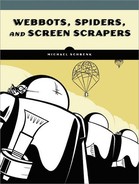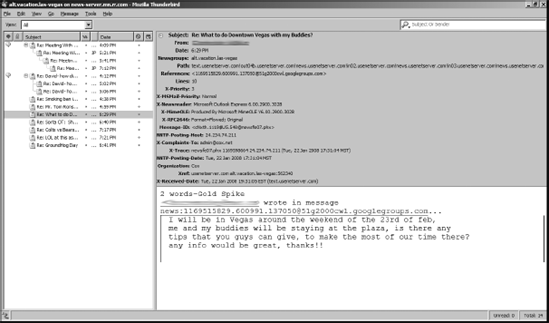Another non-web protocol your webbots can use is the Network News Transfer Protocol (NTTP). Before modern applications like MySpace, Facebook, and topic-specific web forums, NNTP was used to build online communities where people with common interests exchanged information in newsgroups. Members of newsgroups contribute articles—announcements, questions, or answers relating to one of thousands of subject-specific topics. Collectively, these articles are referred to as news. While NNTP is an older Internet protocol, it is still in wide use today, and it provides a valuable source of information for certain webbot projects. I've recently found NNTP useful when working on projects for private investigators, the hospitality industry, and financial institutions.
NNTP originated in 1986[44] and was designed for a network much different from the one we use today. When NNTP was conceived, broadband and always-on access to networks were virtually unheard of. To utilize the network as it existed, NNTP employed a non-centralized server configuration, similar to what email uses. Users logged in to one of the many news servers on the network where they read articles, posted new articles, and replied to old ones. Behind the scenes, NNTP servers periodically synchronized to distribute updated news to all servers hosting specific newsgroups. Today, NNTP servers exchange news so frequently that newly submitted articles appear on news servers across the world almost immediately. In 1986, however, news servers often waited until the early morning hours to synchronize, when phone (modem) calls to the network were cheapest. If the newsgroup process seems odd by today's standards, remember that NNTP was optimized for use when networks were slower and more expensive.
While HTTP has superseded many older protocols (like Gopher[45]), newsgroups have survived and are still widely used today. Most modern communication applications like Microsoft Outlook and Mozilla Thunderbird include news clients in their basic configurations (see Figure 14-1).
While the number of active newsgroups is declining, there are still tens of thousands of newsgroups in use today. The news server I use (hosted by RoadRunner) subscribes to 26,365 newsgroups. Since the variety of topics covered by newsgroups is so diverse (ranging from alt.alien.visitors to alt.www.software.spiders.programming), you're apt to find one that interests you. Newsgroups are a fun source of homegrown information; however, like many sources on the Internet, you need to take what you read with a grain of salt. Newsgroups allow anyone to make anonymous contributions, and themes like conspiracy, spam, and self-promotion all thrive under those conditions.
[44] RFC 977 defines the original NNTP specification (http://www.ietf.org/rfc/rfc977.txt).
[45] Gopher was a predecessor to the World Wide Web, developed at the University of Minnesota (http://www.ietf.org/rfc/rfc1436.txt).

